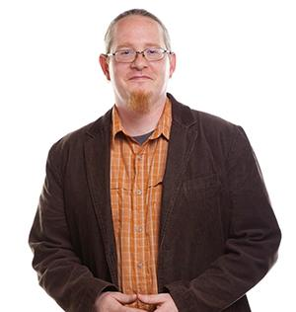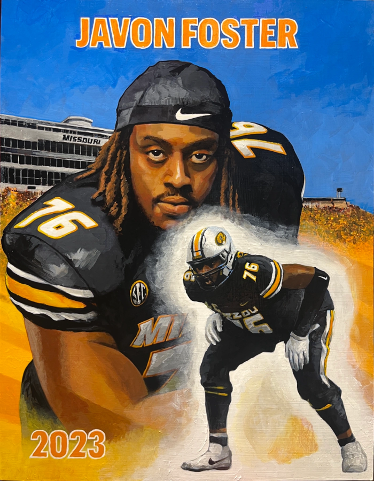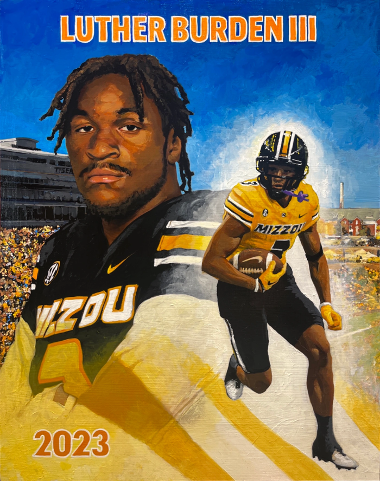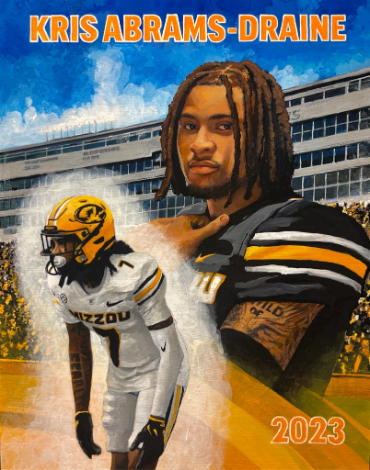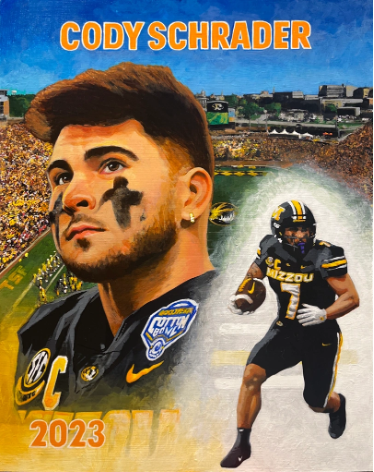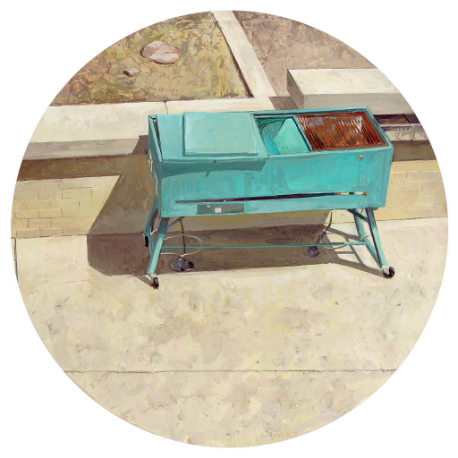Matthew Ballou soon to unveil his 2024 MU football portraits
Since the 1930’s, MU’s athletic department has commissioned an artist to create portraits of its football players titled "All-Americans." In 2019, Matthew Ballou, Full Teaching Professor of painting and drawing, was appointed to continue the tradition, creating four new portraits to be placed along the wall at Faurot Field's South End Zone facility.
An educator, artist and writer, Ballou has shown his artwork over the last several years in solo exhibitions in Kansas, Massachusetts, Missouri, New Hampshire, and Washington.
Ballou recalled his initial reactions of enjoyment when the process started, while making sure to follow a set plan. “Mostly I wanted to be sure that I could enjoy the process. That required meeting with the players, getting visual understanding of what they wanted, and – honestly – making sure the pay would be worth my time. I am actively creating artwork all the time - not to mention the constant classwork and preparation I give to teaching – so I need to know that I can give time to projects that have definitive deadlines before I begin. I don’t want to make substandard stuff in situations like this, so I try to control as much of the creative environment as I can. All of that was in my mind when I began the portraits, and I have appreciated the professionalism and directness I’ve experienced in working with Mizzou Football over the years.”
Ballou's favorite part during the process of making the MU athlete portraits was designing. "I mock things up and then correspond with decision-makers about the look and feel of the portraits, collaborating toward a specific goal while adjusting and shaping the work is always fun. Of course, I also love the tweaking stage toward the end of the painting and bringing all of the parts together.”
Ballou expressed his ability to adapt as an artist when collaborating with organizations and businesses. “I pride myself on generally being able to understand and adapt to the necessities of various projects. Obviously, as an artist I’d prefer to have my creative instincts be valued across the board, but I also really love collaboration. I like working with others, figuring out what they need, and building projects that show effective engagement (which is probably why I love teaching). I’ve done a lot of commissioned portrait work, as well as extensive graphic and product design for people and companies over the last 20 years. In all of those things I think my unique aesthetic is clearly visible. But there is a continuum of authority in any project involving others. In some, like with the sign and design work I do for King Theodore Records here in Columbia (owned by my longtime friend Jesse Slade) I have broad creative freedom. In others, as with the Mizzou Football portraits, the product really has to correspond pretty closely to what they’re requesting and what I’ve pitched, designed, and been approved to create. I like operating within that range.”
As both an educator and artist, Ballou sees these fields as interconnected as he teaches what he enjoys. “These things are intimately connected. They aren’t separate realms to me. All of my work as a practicing artist is integral to my work as an educator. I believe the most effective teaching comes from a place of personally modeling in my own work the practical techniques and conceptual strategies that I present to my students.”
But Ballou needed to take a step back and reprioritize after his heart attack. Ballou explained, “ I can’t be committed to one without proactive attention to the other. As I’ve gotten older (and lived through a heart attack), I’ve learned how to make my life about family, art making, and teaching in a way that nurtures my mental and physical health. It hasn’t always been a perfect balance, but it feels pretty right these days. I say “no” to a lot of things that I used to feel I needed to do.”
Ballou is from Upstate New York, then came to the Midwest in 1999, ready for the change that was to come. “As a young person, I sensed that Upstate was just not going to be conducive to the kind of opportunities I was preparing for. I grew up well below the poverty line and relied on a lot of help to break out (a major scholarship from The School of the Art Institute of Chicago made higher education possible for me). I didn’t go to college until I was 21, so I was in a very serious, focused headspace when I actually got a chance to start school.”
The change of scenery helped not only Ballou’s art journey, but his personal growth. “While a terrifying culture shock at first, living in Chicago did a lot for my development. Upstate NY is beautiful – I really miss the light, air, and landscape of New York from the Catskills to the Adirondacks – I don’t know that I could ever live there again. I enjoy Columbia, not least because two of my children were born here. I just love Midwest college towns. I fell in love with Bloomington, IN while in grad school, and Columbia feels quite a lot like that to me. It’s got a small town feel with access to bigger town culture not too far away.”
Apart from his MU Football portraits, his portfolio is full of a range of eye-catching abstractions, landscapes, figures, representational, and other portraits. One of Ballou’s favorite works is Enigma (Teal Grill). Ballou describes his love for the piece, “It depicts a grill sitting in a courtyard outside of Bingham Commons between Hatch and Schurz Halls on the Mizzou campus. The color, geometry, and light of the piece continues to excite me. I made several representational paintings during that time that feel like the best I’ve ever made. There’s a focus of attention, a sensitivity to surface and form, and a calm, iconographic quality in those pieces that I still really love."
With his journey as an artist and educator, Ballou has thought about the kind of legacy he wants to leave behind in relation to his artwork and his recognized passion as an educator. Ballou shares his wish stating,
“I want to be known as an artist who is a serious investigator of form and color, exploring the potential for artworks to manifest affirmative expressions of sensate human presence. Specifically, I look for shapes, colors, and spaces that go far beyond a simple tension between figuration and abstraction, trying instead to suggest a layered arena of observational and haptic information. Artworks are artifacts of human experiences, and so they should evoke interesting experiences in viewers. I try to make works that cause viewers to attend to their own awareness and embodiment.
As an educator I aim to craft learning environments that are fun, open, and encouraging. I want to help students access their creativity and ability to use attention and awareness effectively. I hope to be known for my enthusiasm regarding not only making art and communicating ideas about art, but also the potential of my students to become thoughtful, engaged citizens of the world. Probably what I love best about teaching is the ongoing relationships I have with former students, many of whom have gone on to become important collaborators with and inspirations to me.”
